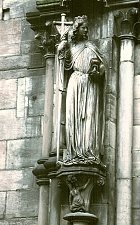That is a good point Diana... One that will take me a while to ponder. There is little evidence that the card derives from Pope Joan but I find no evidence at this time that supports ties to any Biblical Mary. In reviewing the postings on this board I noticed an interest in the history of the Church in regard to females holding actual religious rank. Unlike Mary, the High Priestess and Pope Joan, there is some documentation of how women were ostracized from Church heirarchy. Many believe Mary Magdalene started a Church that promoted Gnostic style sexual equality in religious practices. By following that theory I uncovered the following information.
Gnosticism became a catchall terminology of Christian fundamentalists to demonize other belief systems and combine them into a perceived threat to rally support of moderate Christians. Gnosis, derived from Greek, means knowledge but implies wisdom restricted to a select group. Many Gnostic orders in the first and second centuries sought a reunification with the Divine through distinctly Christian paths but specifics on Gnostic cults remain hidden. Gnosticism and elements of the Kabbalah suggest spiritual dualism. Not only Kabalists but also non-Kabalistic Judaism and other beliefs, which did not strictly comply with fundamentalist Christian doctrine, suffered persecution from 325 CE until the end of Albigensian Inquisition in 1321 CE. Before 325, Gnostic, Christian and Jew banded together. All had rights in Rome to gain respect as entertainers in the Coliseum, in what often became a final act that provided a balanced diet for lions.
Church strategy, which features a tactic of lumping rivals together and then portraying them as bringing Divine Wrath upon the world, depicted religious dissention as a horrific threat. Conversely, in the first and second centuries before the Council of Nicea, dissension in beliefs posed little threat to Christianity. After his vision and subsequent spiritual breakthrough, Constantine, the first Holy Roman Emperor ended Christian persecution but doctrines endorsed by his Council at Nicea set in motion long-term persecution of many other religions, including those that maintained slightly dissimilar Christian beliefs. An acclaimed Christian historian Hermias Sozomen describes resolution of Arian Heresy, addressed by the Council. “The emperor punished Arius with exile, denouncing him and his adherents as ungodly, and commanding that their books should be destroyed.” According to Sozomen, in his text Ecclesiastical History, Arian doctrine offers that there was a period when Christ “existed not; that, as possessing free will, He was capable of vice and virtue.” Destroying records for this seemingly moderate form of heresy suggests that all Christian records depicting God as anything other than a father figure added fuel to Nicene-like book bonfires. Sozomen, like other historians, wrote approved history. Specific description of even a main heresy addressed by the Council invited the wrath of book burners, which Sozomen survived. The Emperor and bishops at Nicea, to some degree, controlled the historic record, which started centuries of control by the Church they created.
Sozomen mentions no distinctly Gnostic Christian sect in attendance at Nicea but Arius purportedly drew an inordinately large female following, which suggests a potential conclusion. Sources state Arius taught dogma of Paul of Samosata, patriarch of Antioch from 260 until excommunication in 270 CE and advanced Paulianist Doctrine. In supporting heretic principals detailed in the Sozomen list of Council rulings, Paul earned a position in history. “Canon XIX. “With regard to Paulianists who take refuge in the Catholic Church, it has been decided that they definitely need to be [re]baptized. If, however, some of them have previously functioned as priests, if they seem to be immaculate and irreprehensible, they need to be baptized and ordained by a bishop of the Catholic Church. In this way, one must also deal with deaconesses or with anyone in an ecclesiastical office. With regard to the deaconesses who hold this position we remind [church leaders] that they possess no ordination but are to be reckoned among the laity in every respect.” It becomes clear that this statement implies that female deaconesses previously held ecclesiastical offices in Christian Churches, specifically churches associated with Paul of Samosata. Like Arian practices, the Council condemned Paulianist Doctrine. Another important historian outlined actions of Paul of Samosata. The ecclesiastical historian Eusebius, a bishop from Palestine, often referred to as the father of church history, reports in Historia Ecclesiastica, Volume VII. Chapter 30, that Paul consorted with “two sisters of ripe age and fair to look upon.” It goes on to say that, he allowed presbyters or deacons to contract platonic unions with Christian women. No actual lapses of chastity are alleged, and it supposedly “only raised suspicions among the pagans.”


